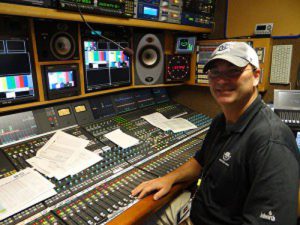Fox Sports’ Broadcast Sound for the MLB All-Star Game Covers More Ground Than Ever
Workflow efficiencies are also part of baseball’s audio evolution
Broadcast baseball continues its immersive evolution, led in large part by Fox Sports, which will air MLB’s All-Star Game today from Nationals Park in Washington, DC. The All-Star Game is one of the season milestones, along with postseason games, that the network has been using to incrementally implement new audio strategies. The first implementation was three years ago when Fox began planting microphones in the ground around the infield/outfield border and used subsequent high-profile events to add them around home plate and the pitcher’s mound, as well as on selected players and umpires. Last year, Fox Sports experimented with two-way communications, via IFB, between defensive players on the field and announcer Joe Buck in the booth. This year’s All-Star Game will expand on those initiatives.
According to A1 Joe Carpenter, 16 microphones will be buried in the outfield as in the past. They will be the same moisture-resistant Quantum5X QT-5100 AquaMic, whose internal lithium battery lasts eight to 12 hours on a single charge and can be turned on and off remotely. However, they’ll be largely aimed in mono, after attempts at pairing them for stereo effects proved less effective than hoped for.
Carpenter and submixer Bob Qua considered a bit of “Billyball” calculations for microphone placement, referring to charts that showed where in the outfield balls have been hit in the past. However, they will use center field as the main plot axis and place microphones to the left and right of that, relying on parabolic mics to capture sound from the extreme ends of the outfield.
“To get all of the outfield covered, we’d have to have another 16 microphones in the ground,” Carpenter explains, noting the already complex matrix Fox Sports deploys: 78 field microphones; 12 RF player, announcer, and umpire mics; eight RF FX mics; nine RF base mics; and 14 RF infield microphones. More than 260 strands of fiber and three-plus miles of fiber-optic cable will support a dozen transmission paths for audio and 35 HD game cameras.
Player/Umpire Mics
Among the biggest successes of the audio-capture strategy, says Carpenter, have been mics placed around the pitcher’s mound and the lavalier on the home-plate umpire. The All-Star Game’s exhibition status loosens some restrictions there, such as when a batter and an umpire take a collective selfie, which happened last year and is likely to occur again. As many as six players may be miked this year, including one or two wearing two-way IFB lavs that connect them with the announcers. Carpenter notes that the nature of the All-Star Game, with dozens of players constantly rotating in and out, keeps multiple A2s in the two dugouts busy removing and applying transmitters and receivers throughout the game.
Much of this player audio will be live, as it was when Washington Nationals right fielder Bryce Harper and Houston Astros center fielder George Springer were miked during the game in Miami last year. Carpenter says the league has come to appreciate the dimensionality that the additional effects audio provides to viewers and have come to trust his and his team’s judgments on when to leave a mic channel open.
“We have a lot more leeway now than when we started,” he explains. “The important thing is to capture the athleticism of the game and to not tip off on strategy. The two-way conversations from the field are especially amazing, and they were live. It was ground-breaking TV.”
Managing all this sound has had its own evolution as the sheer number of microphones has grown. Under the original strategy, Qua handled effects microphones from the outfield and the bases, and Fred Ferris and Carpenter mixed what Carpenter calls the game’s traditional sonic staples, such as the bat cracks captured by the parabs. This year, he says, the network will experiment with having several microphones share a voltage-controlled amplifier (VCA), so that, when Qua opens a microphone near a base, several mics buried nearby in the grass will also open up, broadening the range of sound that can be captured.
Carpenter describes a tactic he has developed for golf (with microphones buried in the hole cups) in which he stays in very tight communication and coordination with specific video-replay operators, so that a great audio clip can be quickly paired with its video and replayed.
“You know which operators have responsibilities for which cameras,” he notes. “I can talk to them about a specific pitch or play that I can have the audio cued up for quickly, so they can match the video with it.”
Yet another audio-management tactic is Carpenter’s hope that last year’s console settings for his mix from the Calrec Apollo console aboard Game Creek’s Yogi truck can translate, as data on a thumb drive, to the Apollo desk on Game Creek’s Encore, which Fox Sports is using for the All-Star Game.
“It won’t be able to get everything over,” he says. “But, if it works, I’ll have settings like EQ and auxes ready to go immediately. It’ll save me hours of programming and tweaking.”
Carpenter expects audio for baseball to keep evolving, with techniques pioneered at events like the All-Star Game eventually becoming a routine part of the broadcast. “Every time we do it, we take up another notch. It’s really exciting stuff.”
For more of SVG’s on-site coverage from Washington D.C., visit the SportsTechLive Blog: On Site at MLB All-Star 2018.

